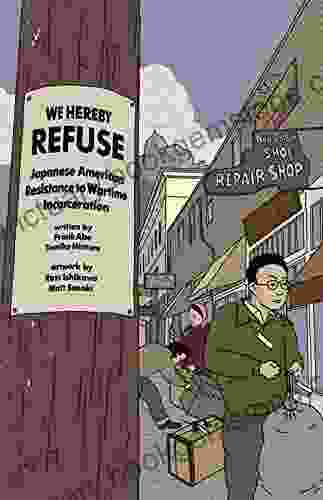Japanese American Resistance to Wartime Incarceration: A Legacy of Strength and Resilience

The forced removal and incarceration of Japanese Americans during World War II stands as a dark chapter in American history. In the wake of the Pearl Harbor attack, over 120,000 Japanese Americans, including both citizens and non-citizens, were forcibly removed from their homes and incarcerated in detention camps scattered across the country.
4.8 out of 5
| Language | : | English |
| File size | : | 32328 KB |
| Screen Reader | : | Supported |
| Print length | : | 194 pages |
Despite the unimaginable hardships and discrimination they faced, Japanese Americans remained resilient and fought back against injustice. Their resistance took many forms, from legal challenges to grassroots activism. This article explores the various ways in which Japanese Americans resisted wartime incarceration, highlighting their strength, courage, and determination.
Legal Challenges
One of the most important forms of resistance was through legal challenges. Japanese Americans challenged the constitutionality of their incarceration in a series of court cases. The most famous of these cases was Korematsu v. United States, which reached the Supreme Court in 1944. The Court ruled against Korematsu, upholding the government's authority to detain Japanese Americans without due process.
However, the legal challenges continued, and in 1988, the Civil Liberties Act of 1988 was passed. This law apologized for the wartime incarceration and provided reparations to survivors. It also established the Commission on Wartime Relocation and Internment of Civilians, which documented the history of Japanese American incarceration.
Grassroots Activism
In addition to legal challenges, Japanese Americans also engaged in grassroots activism to resist their incarceration. They formed organizations such as the Japanese American Citizens League (JACL) and the American Civil Liberties Union (ACLU) to fight for their rights. They also organized protests, demonstrations, and boycotts to raise awareness of their plight.
One of the most effective forms of grassroots activism was the "Fair Play" campaign. This campaign, led by JACL, aimed to change public opinion about Japanese Americans and to pressure the government to end the incarceration. The campaign used a variety of tactics, including media outreach, letter-writing campaigns, and public speaking events.
Resistance in the Camps
Even within the confines of the detention camps, Japanese Americans continued to resist. They organized cultural events, educational programs, and self-governance councils. They also created newspapers and other publications to share their stories and to keep their spirits up.
One of the most famous examples of resistance in the camps was the Manzanar strike. In 1942, the War Relocation Authority (WRA) ordered the residents of the Manzanar camp to sign loyalty oaths. Many Japanese Americans refused, and the camp erupted in a strike that lasted for weeks. The strike was eventually broken, but it showed the WRA that Japanese Americans were not willing to give up their rights without a fight.
Legacy of Resistance
The resistance of Japanese Americans during wartime incarceration is a legacy of strength and resilience. Despite the hardships they faced, they remained determined to fight for their rights and to preserve their culture. Their resistance helped to shape the course of American history and to ensure that such a tragedy never happens again.
The legacy of Japanese American resistance is still felt today. The Civil Liberties Act of 1988 and the Commission on Wartime Relocation and Internment of Civilians are both reminders of the importance of fighting for justice and protecting civil liberties. And the Japanese American community continues to be a vibrant and active force in American society, working to promote understanding and tolerance.
The Japanese American resistance to wartime incarceration is a story of courage, resilience, and determination. Despite the unimaginable hardships they faced, Japanese Americans fought back against injustice and helped to shape the course of American history. Their legacy is a reminder of the importance of fighting for what is right, even in the face of adversity.
4.8 out of 5
| Language | : | English |
| File size | : | 32328 KB |
| Screen Reader | : | Supported |
| Print length | : | 194 pages |
Do you want to contribute by writing guest posts on this blog?
Please contact us and send us a resume of previous articles that you have written.
 Best Book
Best Book Page Flip
Page Flip Bookshelf
Bookshelf Literary loom
Literary loom Chapter
Chapter Bookish
Bookish PageTurner
PageTurner Bibliophile
Bibliophile Story
Story Inkwell
Inkwell Bookworm
Bookworm Labyrinth
Labyrinth Plot Twist
Plot Twist Prose
Prose Paperback
Paperback Storyteller
Storyteller Sanctuary
Sanctuary Fiction
Fiction Reading
Reading Chronicle
Chronicle Read
Read Steven Bleicher
Steven Bleicher Judy Omar
Judy Omar Angie Cruz
Angie Cruz Diana Gabaldon
Diana Gabaldon Jane Akshar
Jane Akshar Lakisha Johnson
Lakisha Johnson Ernest Hemingway
Ernest Hemingway Elizabeth L Block
Elizabeth L Block Maggie O Farrell
Maggie O Farrell Kimberly Brock
Kimberly Brock Robert Ludlum
Robert Ludlum Christopher Fowler
Christopher Fowler Wendy Jelbert
Wendy Jelbert L T Ryan
L T Ryan Tim Slessor
Tim Slessor Erin Lewis Fitzgerald
Erin Lewis Fitzgerald Ann Blockley
Ann Blockley Andrew Marble
Andrew Marble Jarrett Brandon Early
Jarrett Brandon Early G J Younghusband
G J Younghusband Anne Billson
Anne Billson B Love
B Love Andrea Pomerantz Lustig
Andrea Pomerantz Lustig Anna Bartlett
Anna Bartlett Dorothy Hartley
Dorothy Hartley Raymond F Jones
Raymond F Jones Shellise Berry
Shellise Berry Sherry Ginn
Sherry Ginn Andrew Bowden
Andrew Bowden Charlie English
Charlie English Angus M Gunn
Angus M Gunn Andy Mcdermott
Andy Mcdermott Andy Southall
Andy Southall Andrew Carroll
Andrew Carroll Joshua Rivkin
Joshua Rivkin Anjali Enjeti
Anjali Enjeti Fawzia Koofi
Fawzia Koofi Anna Todd
Anna Todd Anna Pasternak
Anna Pasternak Ann Budd
Ann Budd Sergio Bizzio
Sergio Bizzio Leslie Redhead
Leslie Redhead Kianna Alexander
Kianna Alexander Simon Schama
Simon Schama Kindle Edition With Audio Video
Kindle Edition With Audio Video Andrea Fazzari
Andrea Fazzari Tiffany L Warren
Tiffany L Warren Mari K Eder
Mari K Eder Andy Mcnab
Andy Mcnab Mark Henwick
Mark Henwick D C Robinson
D C Robinson Angela Wolf
Angela Wolf Martin Cruz Smith
Martin Cruz Smith Patricia Preciado Martin
Patricia Preciado Martin Ernesto Che Guevara
Ernesto Che Guevara Zachary Lamothe
Zachary Lamothe Anne C Heller
Anne C Heller Tina Brown
Tina Brown Kent Wong
Kent Wong Joseph E Persico
Joseph E Persico Stacey L Nash
Stacey L Nash Anna Sherman
Anna Sherman Andrew Bostock
Andrew Bostock Gary Faigin
Gary Faigin Juanitta Baldwin
Juanitta Baldwin Denny S Bryce
Denny S Bryce Jack Porter
Jack Porter Andrew Darby
Andrew Darby Lance Esplund
Lance Esplund Larry Silverberg
Larry Silverberg Kevin Grange
Kevin Grange Marie Force
Marie Force Quincy Jones
Quincy Jones J Bright
J Bright Kindle Edition
Kindle Edition Elaine Welteroth
Elaine Welteroth Lyonel Feininger
Lyonel Feininger Andrew Forkner
Andrew Forkner Royd Tolkien
Royd Tolkien Jack Gernsheimer
Jack Gernsheimer Julie Klassen
Julie Klassen Andrew Parker
Andrew Parker Emiko Davies
Emiko Davies Emily Bingham
Emily Bingham Frank Kennedy
Frank Kennedy Sarah Herman
Sarah Herman Dita Von Teese
Dita Von Teese Taylor Michaels
Taylor Michaels Siren
Siren Michael Asher
Michael Asher Andreas Deja
Andreas Deja Anna Cavallo
Anna Cavallo Edward Seidensticker
Edward Seidensticker Anna Qu
Anna Qu D C Palter
D C Palter Darrin Duford
Darrin Duford Laura Lee
Laura Lee Jeremy Mercer
Jeremy Mercer Crystal Daniels
Crystal Daniels Jason Sommer
Jason Sommer Andrew M Dobell
Andrew M Dobell Denys Johnson Davies
Denys Johnson Davies Angus Johnstone
Angus Johnstone Andrew Osmond
Andrew Osmond Bruce Feiler
Bruce Feiler Anna Malaika Tubbs
Anna Malaika Tubbs Andrew Sutton
Andrew Sutton James Martin
James Martin Liz Neves
Liz Neves Val Wake
Val Wake Cornel West
Cornel West Anna Jean Mayhew
Anna Jean Mayhew Jonathan Rauch
Jonathan Rauch Brian Shea
Brian Shea Andrea Erickson
Andrea Erickson John Gilstrap
John Gilstrap Mike Epps
Mike Epps Monica Moody
Monica Moody Andrei Codrescu
Andrei Codrescu Josh Hanagarne
Josh Hanagarne Ronnie Smith
Ronnie Smith Marilyn Chase
Marilyn Chase C Y Croc
C Y Croc Angel Williams
Angel Williams Annie Dillard
Annie Dillard John Patrick Bray
John Patrick Bray Roman Frister
Roman Frister J C Cooper
J C Cooper Angelique V Nixon
Angelique V Nixon Michael Tubbs
Michael Tubbs Harriet Welty Rochefort
Harriet Welty Rochefort William J Lederer
William J Lederer Anna Kirtlan
Anna Kirtlan Frederic Lombardi
Frederic Lombardi Anna Paola Sanna
Anna Paola Sanna Anna M Mazur
Anna M Mazur Farha Ghannam
Farha Ghannam Nicholas Meyer
Nicholas Meyer Christina Klein
Christina Klein Ys Publishing
Ys Publishing Condoleezza Rice
Condoleezza Rice Lisa Dickey
Lisa Dickey Carole Jackson
Carole Jackson Cissy Houston
Cissy Houston Anna Hackett
Anna Hackett Anika Fajardo
Anika Fajardo Anne Bogart
Anne Bogart Jill Braden
Jill Braden David Blatner
David Blatner E M Foner
E M Foner C L Parker
C L Parker Michael Howard
Michael Howard John Charles Bennett
John Charles Bennett George Kalmpourtzis
George Kalmpourtzis Christopher Greyson
Christopher Greyson Jane Dunnewold
Jane Dunnewold Annabel Chase
Annabel Chase E B Sledge
E B Sledge Nintendo
Nintendo Anna Stephens
Anna Stephens Edward Bellamy
Edward Bellamy Ann Aguirre
Ann Aguirre Anna Koliadych
Anna Koliadych Jocelyn Harewood
Jocelyn Harewood Octavio Solis
Octavio Solis Andrew Cunningham
Andrew Cunningham Jessica Alba
Jessica Alba Anna Nadler
Anna Nadler Andrew Dickos
Andrew Dickos Rickie Lee Jones
Rickie Lee Jones Heather Galler
Heather Galler T J Demos
T J Demos Tetiana Elert
Tetiana Elert Stephanie Laurens
Stephanie Laurens Jamila Jasper
Jamila Jasper Duncan Heath
Duncan Heath Andrew Vaillencourt
Andrew Vaillencourt Walter Foster
Walter Foster Ann C Smith
Ann C Smith Kent Babb
Kent Babb Jack Lucas
Jack Lucas Andy Mckell
Andy Mckell Ryan White
Ryan White Christopher S Wood
Christopher S Wood Andrea Pflaumer
Andrea Pflaumer Maxim Peter Griffin
Maxim Peter Griffin Billy Ray Belcourt
Billy Ray Belcourt Shirley Anstis
Shirley Anstis Bathroom Readers Institute
Bathroom Readers Institute Erika Warmbrunn
Erika Warmbrunn Andrew Mayne
Andrew Mayne Angelina Jolie
Angelina Jolie Ann C Hall
Ann C Hall Royal Horticultural Society
Royal Horticultural Society Andy Keen
Andy Keen Angus Roxburgh
Angus Roxburgh Liao Yiwu
Liao Yiwu Andrew Moriarty
Andrew Moriarty Van Lu
Van Lu Octave Uzanne
Octave Uzanne Andrew Wilson
Andrew Wilson Jason Kramar
Jason Kramar Annalee Newitz
Annalee Newitz Andy Warhol
Andy Warhol Andrea Lee
Andrea Lee Godfrey Baldacchino
Godfrey Baldacchino Ann Hoffman
Ann Hoffman Shel Perkins
Shel Perkins Dominique Auzias
Dominique Auzias Lonneke Geerlings
Lonneke Geerlings Doris Kennedy
Doris Kennedy J B Rosenberg
J B Rosenberg Kate Frost
Kate Frost Drew Kwong
Drew Kwong Charles Reid
Charles Reid David Loud
David Loud Jenny Schwartz
Jenny Schwartz Betty Arnett
Betty Arnett John Sugden
John Sugden Robin Sloan
Robin Sloan Michael Punke
Michael Punke Angelico Chavez
Angelico Chavez Hamish Bowles
Hamish Bowles Kristina Liu
Kristina Liu Fred Saberhagen
Fred Saberhagen Don Bluth
Don Bluth Harry Houdini
Harry Houdini Anna Salton Eisen
Anna Salton Eisen Anna Corba
Anna Corba Ben G Frank
Ben G Frank Disamis Arcia Munoz
Disamis Arcia Munoz Andrei Besedin
Andrei Besedin Laura Bradbury
Laura Bradbury Andreas Marks
Andreas Marks Anita Heiss
Anita Heiss Ruskin Bond
Ruskin Bond Ted Kerasote
Ted Kerasote Stuart Campbell
Stuart Campbell Bill Fawcett
Bill Fawcett John C Cranham Dds
John C Cranham Dds Terry Newman
Terry Newman Cion Lee
Cion Lee James Canton
James Canton Isabel Allende
Isabel Allende Kliph Nesteroff
Kliph Nesteroff Jeb Rosebrook
Jeb Rosebrook Flavio Ferrari Zumbini
Flavio Ferrari Zumbini Robin Koontz
Robin Koontz Kien Nguyen
Kien Nguyen Mark Horrell
Mark Horrell David Hampshire
David Hampshire Holly Moss
Holly Moss Anna Starmer
Anna Starmer Frederick Stirton Weaver
Frederick Stirton Weaver Fern Michaels
Fern Michaels Magic Guidebooks
Magic Guidebooks Regine Abel
Regine Abel David Mamet
David Mamet Jeffrey Chipps Smith
Jeffrey Chipps Smith Michiyo
Michiyo Scott Bartlett
Scott Bartlett Elisa Russell
Elisa Russell Nancy Princenthal
Nancy Princenthal Xander Black
Xander Black Anna Mocikat
Anna Mocikat Charla Krupp
Charla Krupp Andrew Moor
Andrew Moor Anette Fischer
Anette Fischer Hilary Spurling
Hilary Spurling Kristina Kozak
Kristina Kozak Sylvan Barnet
Sylvan Barnet John Driver
John Driver Tom Sileo
Tom Sileo Andy Herbach
Andy Herbach Angie Grace
Angie Grace Andrew Karevik
Andrew Karevik W H Bartlett
W H Bartlett Angharad Lewis
Angharad Lewis Louise Egerton
Louise Egerton Stephen Kurkjian
Stephen Kurkjian Natasha Solomons
Natasha Solomons Anjan Chatterjee
Anjan Chatterjee Rhonda Mcknight
Rhonda Mcknight Andrew Porwancher
Andrew Porwancher Padma Lakshmi
Padma Lakshmi Susan Ross
Susan Ross Glenn Adamson
Glenn Adamson Scott Thybony
Scott Thybony Theodore Annemann
Theodore Annemann Jane Hamilton
Jane Hamilton Jean Ann Shirey
Jean Ann Shirey Kitty Gorrell
Kitty Gorrell Barbara Sillery
Barbara Sillery Angus Donald
Angus Donald Robert Alan Brookey
Robert Alan Brookey Julie Ann Walker
Julie Ann Walker Terry Brooks
Terry Brooks Yossi Maimon
Yossi Maimon Paul Robert Walker
Paul Robert Walker Dawnie Walton
Dawnie Walton Andrew Juniper
Andrew Juniper Mia Sheridan
Mia Sheridan Bernie Marcus
Bernie Marcus James T Deshields
James T Deshields Sam Fury
Sam Fury Anita Nipane
Anita Nipane Michelle Lee
Michelle Lee Emma Newman
Emma Newman Nicholas Roerich
Nicholas Roerich Angela D French
Angela D French Diane Esguerra
Diane Esguerra Andrew Tunstall
Andrew Tunstall Henry Van Dyke
Henry Van Dyke Alex Tannen
Alex Tannen Manuel Huitzilli
Manuel Huitzilli Fred Botting
Fred Botting Eric Seale
Eric Seale Andrew Meier
Andrew Meier Gabrielle Moss
Gabrielle Moss Rita Moreno
Rita Moreno Clemantine Wamariya
Clemantine Wamariya Guy Stern
Guy Stern Paul Reps
Paul Reps Pao Lor
Pao Lor Angie Daniels
Angie Daniels John F Mullins
John F Mullins Andrew Hund
Andrew Hund Kathryn Wilder
Kathryn Wilder Marc Shapiro
Marc Shapiro Rachel Rubin Wolf
Rachel Rubin Wolf Josie Iselin
Josie Iselin Danielle Prescod
Danielle Prescod Melissa Riddell
Melissa Riddell Angela Gaughan
Angela Gaughan Ann Marks
Ann Marks Howard Thurston
Howard Thurston Andrew Delaplaine
Andrew Delaplaine Andrew Vietze
Andrew Vietze Andrew Graham Dixon
Andrew Graham Dixon Ann Beaglehole
Ann Beaglehole Michele Sullivan
Michele Sullivan Anna Goldenberg
Anna Goldenberg Angelo Colorni
Angelo Colorni Katrina Mcpherson
Katrina Mcpherson Gavin Ambrose
Gavin Ambrose Catherine Berry
Catherine Berry Haley Hoover
Haley Hoover Anita Brookner
Anita Brookner Shawn Kelly
Shawn Kelly Anna Badkhen
Anna Badkhen Caroline Linscott
Caroline Linscott Jake Sherman
Jake Sherman Dominic Roskrow
Dominic Roskrow Angie Martinez
Angie Martinez Rob Craig
Rob Craig J D Robb
J D Robb Graeme Davis
Graeme Davis Jeff Fletcher
Jeff Fletcher J N Chaney
J N Chaney Scott Baron
Scott Baron William W Johnstone
William W Johnstone Danielle Geller
Danielle Geller Tony Wheeler
Tony Wheeler Nina Willner
Nina Willner Angela Hunt
Angela Hunt David J Dennis Jr
David J Dennis Jr Andrew Dewar
Andrew Dewar Donald Preziosi
Donald Preziosi Patrick Smithwick
Patrick Smithwick Sarah Ferguson
Sarah Ferguson Erwin Panofsky
Erwin Panofsky Gary Spetz
Gary Spetz Ani Trime
Ani Trime Nicole Grotepas
Nicole Grotepas Sara Funduk
Sara Funduk Zane Lamprey
Zane Lamprey Phoenix Collins
Phoenix Collins Dave Clayton
Dave Clayton Emily Louise Howard
Emily Louise Howard Ann Cleeves
Ann Cleeves Andrew Grant
Andrew Grant L J Martin
L J Martin Andrea Jackson
Andrea Jackson Legacy Russell
Legacy Russell Ed Duncan
Ed Duncan Ray Scippa
Ray Scippa Andrew Johnson
Andrew Johnson Camil Flores
Camil Flores Chris Weyers
Chris Weyers Mary Robinette Kowal
Mary Robinette Kowal Anne Pannecke
Anne Pannecke Anna Deavere Smith
Anna Deavere Smith Charles Bukowski
Charles Bukowski Caroline James
Caroline James Angela Marie Moulton
Angela Marie Moulton Barbara Lasalle
Barbara Lasalle Andrew Haslam
Andrew Haslam Marina Benjamin
Marina Benjamin Yan Lianke
Yan Lianke Margaret Wander Bonanno
Margaret Wander Bonanno Christie Taylor
Christie Taylor Andrew Mcmahon
Andrew Mcmahon Shannon Leone Fowler
Shannon Leone Fowler Andy Davidson
Andy Davidson Annabelle Honess Roe
Annabelle Honess Roe David Nees
David Nees R G Richardson
R G Richardson Dina Nayeri
Dina Nayeri Laurinda Reddig
Laurinda Reddig Bridget Alsdorf
Bridget Alsdorf Carlos Del Amor
Carlos Del Amor Waldemar Bogoras
Waldemar Bogoras Kat Chow
Kat Chow Christine Leteux
Christine Leteux Milton Glaser
Milton Glaser John M Olsen
John M Olsen Sylvia Day
Sylvia Day Lynda Vaughn
Lynda Vaughn Anjelah Johnson Reyes
Anjelah Johnson Reyes Luis Carlos Montalvan
Luis Carlos Montalvan Daniella Weiss Ashkenazy
Daniella Weiss Ashkenazy
Light bulbAdvertise smarter! Our strategic ad space ensures maximum exposure. Reserve your spot today!

 Shannon SimmonsAn Extraordinary Journey: The Autobiography of a 12-Year-Old Boy Who Left His...
Shannon SimmonsAn Extraordinary Journey: The Autobiography of a 12-Year-Old Boy Who Left His... Glen PowellFollow ·8k
Glen PowellFollow ·8k Bryson HayesFollow ·10k
Bryson HayesFollow ·10k Edmund HayesFollow ·16.3k
Edmund HayesFollow ·16.3k Rod WardFollow ·14.2k
Rod WardFollow ·14.2k Paulo CoelhoFollow ·8.9k
Paulo CoelhoFollow ·8.9k Shawn ReedFollow ·17.1k
Shawn ReedFollow ·17.1k Ed CooperFollow ·2.4k
Ed CooperFollow ·2.4k John SteinbeckFollow ·8.3k
John SteinbeckFollow ·8.3k

 Ethan Mitchell
Ethan MitchellWe Are Here To Hurt Each Other: A Deep Dive into the...
Yes, I can help you with that. Here is an...

 Xavier Bell
Xavier BellHannah Arendt: A Life in Dark Times
Hannah Arendt was a...

 Donovan Carter
Donovan CarterThe Art of Looking: A Comprehensive Exploration of Visual...
: The Power of...

 Terence Nelson
Terence NelsonUnveiling the Secrets of Moscow's Red Square: A Journey...
In the heart of Moscow,...

 Cruz Simmons
Cruz SimmonsDrawing Workbook for Kids and Beginners: An Enchanting...
: Unveiling the Magic of Drawing Drawing, an...
4.8 out of 5
| Language | : | English |
| File size | : | 32328 KB |
| Screen Reader | : | Supported |
| Print length | : | 194 pages |












